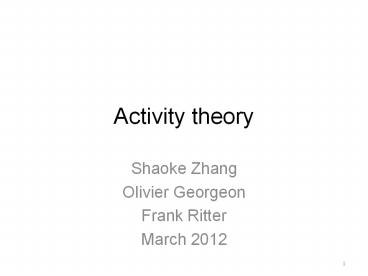Activity%20theory - PowerPoint PPT Presentation
Title:
Activity%20theory
Description:
The theory evolved from the work of Vygotsky (1896-1934) Vygotsky was contemporary of Pavlov, the father of reflexology and then behaviorism ... – PowerPoint PPT presentation
Number of Views:271
Avg rating:3.0/5.0
Title: Activity%20theory
1
Activity theory
- Shaoke Zhang
- Olivier Georgeon
- Frank Ritter
- March 2012
2
Outline
- Introduction
- Philosophical background
- Main concepts and principles
- Implications for human-computer interaction
3
Information-processing approach
Cognition Information/processing
Perception
Action
Subject
Environment
4
Critics (even before IP existed!)
- Martin Heidegger (1889-1976)
- Behavior is prior to knowledge
- Phenomenology
- Jean Piaget (1896-1980)
- Constructivist Epistemology
- Bottom-up-constructed patterns of behavior
- Lev Vygotsky (1896-1934)
- Psychological tools
5
Activity-centered approach
Subjective world
Controls
Constructs
Activity / Experience
Patterns
Constraints
Constructs
Objective world
6
Activity Theory
- The theory evolved from the work of Vygotsky
(1896-1934) - Vygotsky was contemporary of Pavlov, the father
of reflexology and then behaviorism - Vygotsky criticized the mentalist tradition
- Individual consciousness is built from the
outside through relations with others it must be
viewed as products of mediated activity
7
Historical background
- Influenced by the Theory of dialectic
materialism developed by Marx and Engels - For Marx and Engels, labor is the basic form of
human activity Their analysis stresses that in
carrying out labor activity, humans do not simply
transform nature they themselves are also
transformed in the process The tools that are
available at a particular stage in history
reflect the level of labor activity. New types of
instruments are needed to carry out the
continually evolving new forms of labor activity
(Wertsch, 1981p. 134-135)
8
Philosophical background
- Vygotsky appropriated ideas about how tools or
instruments mediate the labor activity and
extended those ideas to include how psychological
tools mediate thought - He plays with the similarity between Marxs
notion of how the tool mediates human labor
activity and the semiotic notion of how sign
systems mediate human social processes and
thinking - His point is that instruments are not only used
by humans to change the world but also they
transform and regulate humans in this process
9
Vygotskys statements
- Psychological tools language, writing, maps
etc.- are artificial formations. By their nature
they are social - They are directed toward the control of
behavioral processes just a technical means are
directed toward the control of processes of
nature - Emphasis on the mediation by psychological tools
in the study of thinking and consciousness
10
Activity Theorys Critique of HCI
- The role of artifact between user and task is
ill-understood - Focus on one user - one computer
- vs. collaboration, work site, team, organization
- Interaction with system seen as end in itself
- vs. a small part of a work/activity system
- Task analysis for user interface design
- fail to capture the complexity and contingency of
real-life action
11
Activity examines Developing situations/systems
- All the elements of the system are continuously
changing. - Subjects not only use tools, they also adapt
them. - They obey rules, and transform them.
- They divide work and innovate.
- finger painting
12
A Perspective of Human Development
- people are socio-culturally embedded actors
- not processors, or system components
- appropriateness of tools for a collective
practice - we design new conditions for collective activity
- qualifications, work environment, division of
labor - conflicts/contradictions in human development
- growth of expertise as solution to conflict in
use - hierarchical analysis of motivated human action
- dynamically integrating levels of activity
analysis
13
Activity System (Engestrom Webb)
OutcomeSuccessWell-being
14
Main concepts
- Subject the individual/subgroup chosen as the
point of view in the analysis. - Tools physical or psychological.
- Community individuals/subgroups who share the
same general object. - Division of labor division of tasks between
members of the community. - Rules explicit/implicit regulations, norms,
conventions that constrains action/interaction - Object the raw material or problem space at
which the activity is directed and which is
molded or transformed into outcomes
15
Vision for human computer interaction
- Human
- Users are actors having intentions/motivations/nee
ds - Interaction
- There is a psychological relation between the
user and the tool - What develops or is important is not always time,
but emotions, social connections, trust - Computer
- A technical system does not immediately
constitute a tool for the user. Even explicitly
constructed as a tool, it is not, as such, a tool
for the user, - A technical system only becomes a tool through
the users activity, - A tool is never given, the user contributes to
its design, - A tool in use is not the object of the users
activity, - Tools can have real and important impacts on
human activity
16
References
- Collins, P., Shukla, S., Redmiles. D. (1999)
Activity Theory and System Design A View from
the Trenches. Computer Supported Cooperative Work
11 55-80. - Halverson, C. A. (2002) Activity theory and
distributed cognition Or what does CSCW need to
DO with theories? Computer Supported Cooperative
Work, 11, 243-267. - Korpela, M, Mursu, A., Soriyan, H. A., and
Olufokunbi, K. C. (2002). Information systems
development as an activity, Computer Supported
Cooperative Work, 11, 111-128. - Bertelsen O. W. (2003) Activity Theory. In
Carroll, J.M. ed., HCI Models, Theories, and
Frameworks Towards and Interdisciplinary
Science, 291-324. Morgan Kaufmann, San Francisco,
CA.































